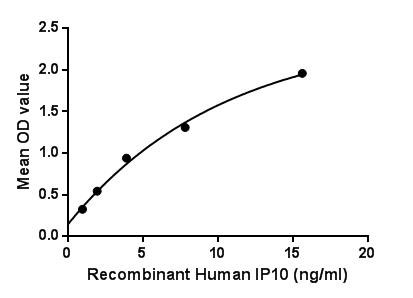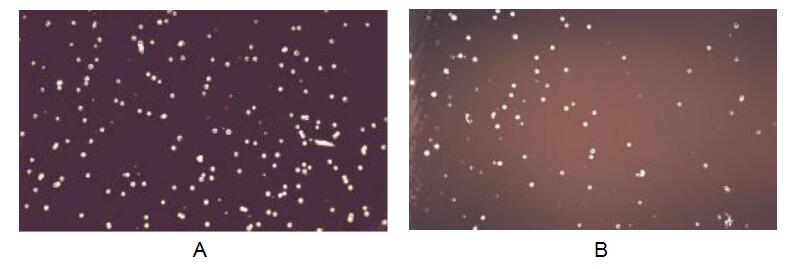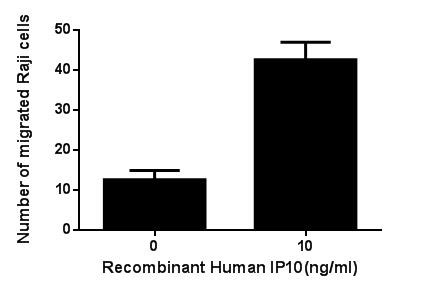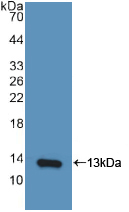
Details
ACTIVITY TEST
Buffer Formulation PBS, pH7.4, containing 0.01% SKL, 5% Trehalose. Traits Freeze-dried powder Purity > 95% Isoelectric Point 10.4 Applications Cell culture; Activity Assays.

Figure. The binding activity of IP10 with IGFBP7.
Interferon gamma-induced protein 10 (IP10) also known as C-X-C motif chemokine 10 (CXCL10) or small-inducible cytokine B10 is an 8.7kDa protein that in humans is encoded by the CXCL10 gene. C-X-C motif chemokine 10 is a small cytokine belonging to the CXC chemokine family. IP10 secreted by several cell types in response to IFN-γ, has been attributed to several roles, such as chemoattraction for monocytes/macrophages, T cells, NK cells, and dendritic cells, promotion of T cell adhesion to endothelial cells, antitumor activity, and inhibition of bone marrow colony formation and angiogenesis. Besides, Insulin Like Growth Factor Binding Protein 7 (IGFBP7) has been identified as an interactor of IP10, thus a binding ELISA assay was conducted to detect the interaction of recombinant human IP10 and recombinant human IGFBP7. Briefly, VDR were diluted serially in PBS, with 0.01% BSA (pH 7.4). Duplicate samples of 100uL were then transferred to IGFBP7-coated microtiter wells and incubated for 2h at 37℃. Wells were washed with PBST and incubated for 1h with anti-IP10 pAb, then aspirated and washed 3 times. After incubation with HRP labelled secondary antibody, wells were aspirated and washed 3 times. With the addition of substrate solution, wells were incubated 15-25 minutes at 37℃. Finally, add 50µL stop solution to the wells and read at 450nm immediately. The binding activity of IP10 and IGFBP7 was shown in Figure 1, and this effect was in a dose dependent manner.
Figure. The chemotactic effect of IP10 on Raji cells.
Chemotaxis assay used 24-well microchemotaxis system was undertaken to detect the chemotactic effect of IP10 on the Raji cell line. Briefly, Raji cells were seeded into the upper chambers (150μL cell suspension, 106 cells/mL in RPMI 1640 with FBS free) and IP10 (1ng/mL, 10ng/mL ,100ng/mL and 1000ng/mL diluted separately in serum free RPMI 1640) was added in lower chamber with a polycarbonate filter (8μm pore size) used to separate the two compartments. After incubation at 37℃ with 5% CO2 for 2h, the filter was removed, then cells in low chamber were observed by inverted microscope at low magnification (×100) and the number of migrated cells were counted at high magnification (×400) randomly (five fields for each filter). Result shows IP10 is able to induce migration of Raji cells. The migrated Raji cells in low chamber at low magnification (×100) were shown in Figure 2. Five fields of each chamber were randomly chosen, and the migrated cells were counted at high magnification (×400). Statistical results were shown in Figure 3. The optimum chemotaxis of IP10 occurs at 10-100ng/mL.
(A) Raji cells were seeded into the upper chambers and serum free RPMI 1640 with 10ng/mL IP10 was added in lower chamber, then cells in lower chamber were observed at low magnification (×100) after incubation for 1h;
(B) Raji cells were seeded into the upper chambers and serum free RPMI 1640 without IP10 was added in lower chamber, then cells in lower chamber were observed at low magnification (×100) after incubation for 2h.
Figure. The chemotactic effect of IP10 on Raji cells
USAGE
Reconstitute in 10mM PBS (pH7.4) to a concentration of 0.1-1.0 mg/mL. Do not vortex.
STORAGE
Avoid repeated freeze/thaw cycles. Store at 2-8°C for one month. Aliquot and store at -80°C for 12 months.
STABILITY
The thermal stability is described by the loss rate. The loss rate was determined by accelerated thermal degradation test, that is, incubate the protein at 37°C for 48h, and no obvious degradation and precipitation were observed. The loss rate is less than 5% within the expiration date under appropriate storage condition.
Image

Figure. SDS-PAGE

Figure. Western Blot
Bought notes(bought amounts latest0)
User Comment(Total0User Comment Num)
- No comment


 +86 571 56623320
+86 571 56623320
 +86 18668110335
+86 18668110335

